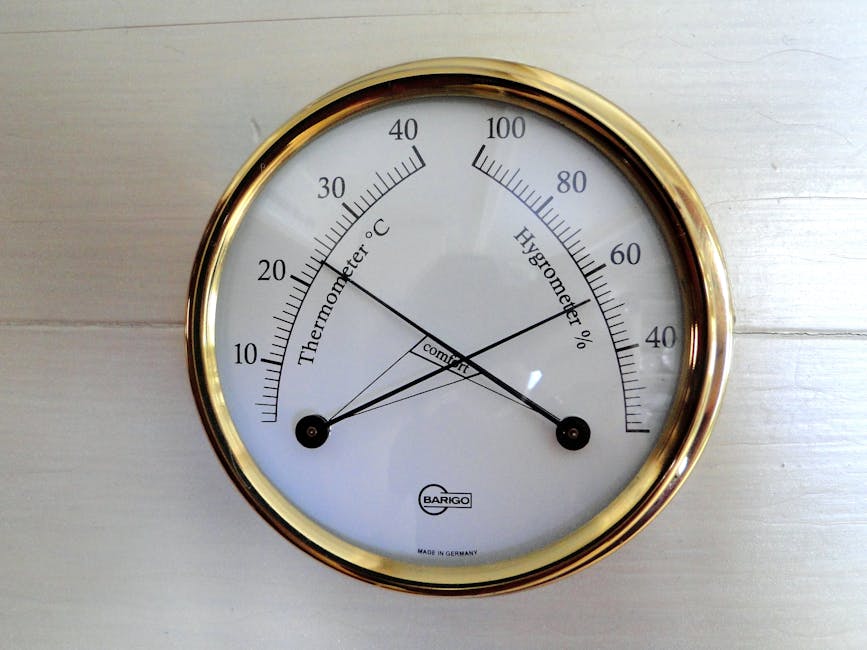Table of Contents
You know, sometimes folks ask me, what’s the one thing, the gadget you reckon every bloke, every lass, oughta have stashed away somewhere, probably in that junk drawer we all got, next to the half-dead batteries and that screwdriver nobody knows what it’s for. My answer, usually, surprises ’em. It ain’t some fancy smart speaker, nor one of them robotic vacuum cleaners that just push dust around. Nah, I always tell ’em, get yourself a half-decent hygrometer.
Yeah, a hygrometer. The look on their faces, priceless. Like I just suggested they buy a pet rock. Most people, they don’t even know what the damn thing is, let alone why it matters. But trust me, after twenty-odd years kicking around the digital ether, seeing all sorts of marketing guff and real-world problems, this little bit of kit, it just keeps proving its worth. It’s not flashy, no, not even a bit. It just sits there, telling you the real story about the air you’re breathing. And a lot of times, that story ain’t pretty.
Think about it, right? We talk about temperature all the time, don’t we? Is it hot enough to melt a welly? Cold enough to freeze the brass off a monkey? But humidity? That’s the silent killer, the invisible troublemaker. Too much, and your house starts feelin’ like a swamp, all clammy, mould sprouting like it’s had a personal invitation. Too little, and you’re cracking up like an old desert boot, sinus drying out, woodwork splitting, guitars getting all wonky.
When the Walls Start Weepin’ – Home Humidity Woes
I saw this once, down in a coastal town, proper Sydney humidity, where the air just hangs like a wet blanket. My mate, lovely fella, bought an old place, “character,” he called it. I called it a damn sponge. He kept complainin’ about his asthma acting up, his old antique chest starting to warp. Turns out, his humidity was sitting at like eighty percent, day in, day out. His walls, they were literally weeping. A good hygrometer would’ve told him this months before the mould patches started resembling abstract art.
That’s the thing about it, knowing the numbers. You can feel it, sure. That sticky feeling on your skin, or the crackle when you touch something metal. But your senses, they lie to you sometimes, or just don’t tell the full tale. The actual relative humidity, that’s what you need. It gives you something to work with. Is your dehumidifier actually doing its job, or just making a lot of noise? Is that humidifier you got for the kid’s cough actually helping, or just making the bedroom a prime breeding ground for nasties? You wouldn’t guess without something showing you the percentage.
Companies That Keep it Dry (Or Wet)
You got companies like AcuRite, you see their stuff in all the big box stores, pretty straightforward, does the job for most homes. Then there’s ThermoPro, another one you’ll spot on the ‘net, good for general household use. They’re built for people who just need a number, quick and easy. My mum, bless her, she’d probably get one of those, stick it on the mantelpiece, and forget what the numbers mean after a week. But for us, for people who actually want to know, these are a decent start. They ain’t gonna break the bank.
Precious Things Need a Proper Eye
It ain’t just about your health or your gaff turning into a fungus farm, mind. Think about anything delicate you own. Musical instruments, for one. Had a guitarist once, swore his axe was cursed. Wouldn’t stay in tune. Turned out, he lived in a place that went from bone dry in winter to muggy as a swamp in summer. That timber, it expands and contracts like a confused accordion. A little hygrometer in his guitar case, or even in the room where he kept it, would have saved him a lot of grief, and probably a few quid on repairs.
Art, too. Books, old photos, anything with paper or wood. If you’ve got a little collection of vinyl, or comics tucked away, humidity is your enemy. It causes warping, foxing, all sorts of nasty stuff that ruins value and just makes things look manky. You put a hygrometer in your storage space, suddenly you’re not just guessing. You’re knowing. You know when to fire up that little desiccant packet, or air the room out, or curse the weather.
Serious Kit for Serious Problems
When you get into the pro stuff, it’s a whole different ballgame. You got the industrial players, the ones making gear that costs a fair chunk of change. Take Vaisala, for instance. Finnish outfit, makes serious kit. Not just for your living room, no. Their stuff’s in factories, power plants, meteorology stations. Measuring humidity in environments where it actually matters for safety or production quality. They ain’t messing around with a simple dial, these are high-precision instruments.
Then there’s Testo, German lot, known for their measurement tech. HVAC engineers swear by their stuff. Imagine you’re running a big building, office block, or a museum even, where climate control isn’t just about comfort, but about preserving priceless artifacts. You need to know the humidity down to a gnats whisker. These companies, they build the real workhorses.
The Cannabis Conundrum – It’s a Thing, Apparently
Now, what’s interesting is how some niche markets have pushed the humble hygrometer into the spotlight. Take the legal cannabis industry, for example. I’m not sayin’ I’m an expert on growing the stuff, but it’s clear as day these folks are obsessed with climate control. From grow tents to drying rooms, humidity, temperature, CO2 levels – it’s all monitored with almost religious zeal. Too humid, you get mould on your buds. Too dry, you lose terpenes, flavour, all the good bits.
So, they’re shelling out for proper sensors. Companies like Govee, they’ve jumped on this, offering smart hygrometers that connect to your phone. Alerts you if things go pear-shaped. It’s not just about growing green; it’s about any agriculture where environmental control makes or breaks the crop. Mushrooms, specialty herbs, you name it. It’s all about keeping things just right. And how would you know without a reliable hygrometer? You just wouldn’t.
Beyond the Home and Grow Tent
You ever think about the air in a cleanroom? Where they make microchips or pharmaceuticals? Tiny variations in humidity can trash an entire batch. You can’t just wing it. They use highly specialized gear from companies like Rotronic, a Swiss outfit. Their sensors are designed for extreme precision, calibration, the whole nine yards. It’s a world away from the little box you get at the hardware store, but it’s still doing the same core job: telling you how much water vapour is floating around.
What about those folks who manage large warehouses, storing sensitive goods? You can’t have your electronics rusting or your cardboard boxes turning to mush. You need constant monitoring. What happens if your hygrometer dies? You need a backup, or at least a regular check to make sure it’s still spitting out accurate numbers. Some cheaper ones, they drift, they lie to you after a while. You buy cheap, you buy twice, right? Old saying, but true.
Why Bother with the Numbers?
I get it. Some folks just don’t care. They live in blissful ignorance, let the mould grow, let their instruments crack. That’s their choice. But for anyone who gives a toss about their stuff, their health, or just not living in a house that feels like a sauna in winter, getting a handle on humidity is a no-brainer. It’s not about being obsessive; it’s about being informed.
Think about the sheer amount of energy we waste. Running air conditioning full tilt to cool a place down when maybe the real problem is the humidity making it feel hotter than it is. A dehumidifier can make a 75-degree room feel a whole lot more comfortable than a sticky 70-degree room. And that saves you money, saves you power. It’s simple economics, really. Your comfort, your pocket.
When You Just Gotta Know: Calibration
So, you get one of these things, right? And it tells you your living room is at 65% humidity. Is it? Or is it lying to you? That’s where calibration comes in. Some of the fancier ones let you adjust them, usually with a salt solution test. You put the hygrometer in a sealed bag with some saturated salt, and it should read a specific humidity level. If it doesn’t, you tweak it. Makes sense, don’t it? What’s the point of a measurement if you can’t trust it? Most people never bother with this, mind. They just believe the number on the screen like it’s gospel. Fools.
Common Questions People Mumble At Me
“So, what’s a good humidity level then?” someone asked me once, just like that. And I told ’em, “Depends. Generally, you’re looking for somewhere between 40% and 60%. Below 30%, you’re probably drying out, above 70%, you’re inviting trouble.” It’s not an exact science for every single case, but that’s a decent range to aim for.
“Do I need a fancy digital one, or will an old analogue one do?” Another classic. My take? Digital, every time. Analogue hygrometers, the old coil ones, they look pretty, sure, but they’re usually about as accurate as a politician’s promise. They drift, they don’t react quickly. A decent digital one, even a cheap one, is generally more reliable. Quicker too. You want to know now, not five minutes ago.
“Can my phone measure humidity?” Some phones claim they can, yeah. But most are just pulling weather data from outside, or have a very basic sensor not designed for ambient room conditions. It’s not the same. You need a dedicated piece of kit for the job. Your phone’s good for gossiping on, not for precise environmental monitoring.
“Is it really worth the fuss?” Worth the fuss? Mate, if you’ve ever had a mould problem, or your antique furniture warped, or your kid struggling to breathe because the air’s too dry, you wouldn’t be asking that. It’s like asking if a smoke detector is worth the fuss. Small investment, potentially huge payoff in avoiding grief.
It really is one of those unglamorous essentials. No one’s going to boast about their new hygrometer at a dinner party, are they? But it’s doing the quiet work, protecting your stuff, maybe even your lungs. And in my book, that’s worth more than any shiny new gadget. You spend a bit, you learn a bit, you save a lot of bother. Simple as that.












